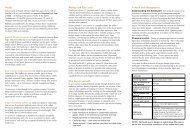Bushland Weeds Manual - Environmental Weeds Action Network
Bushland Weeds Manual - Environmental Weeds Action Network
Bushland Weeds Manual - Environmental Weeds Action Network
Create successful ePaper yourself
Turn your PDF publications into a flip-book with our unique Google optimized e-Paper software.
iv<br />
Introduction<br />
The Banksia, Tuart and Jarrah woodlands, the<br />
shrublands and the species-rich heathlands of the Swan<br />
Coastal Plain and Darling Plateau are wonderful places.<br />
They contribute to Perth’s unique natural landscapes,<br />
provide a window into the natural world, habitat for<br />
native fauna and support an extraordinarily diverse<br />
flora. They are fast disappearing though, mostly under<br />
urban development. Those bushlands that remain face<br />
a range of threats; one of the most serious is invasion<br />
by environmental weeds.<br />
The concept of environmental weeds is still relatively<br />
new. Although the weediness of plants like Bridal<br />
Creeper and Watsonia have become entrenched in the<br />
public psyche, there is some way to go before the wider<br />
community accepts the extent of the problem. For<br />
example, Harlequin Flower (Sparaxis bulbifera) threatens<br />
one of the last remaining clay-based wetlands on the<br />
eastern side of the coastal plain and yet the species was<br />
available this year from a fundraising catalogue in at<br />
least one local primary school. Still, it is evident that<br />
many people do recognise the threats. Increasingly,<br />
community volunteers and state and local governments<br />
are involved in on-ground actions to protect bushland<br />
from the impacts of environmental weeds.<br />
With few resources available, maximising the positive<br />
outcomes of these professional and voluntary efforts is<br />
critical. For those working on the ground, information<br />
on identification and control is available from a number<br />
of good books: Managing Perth’s <strong>Bushland</strong>s (Scheltema<br />
and Harris 1995), Southern <strong>Weeds</strong> and their control<br />
(Moore and Wheeler 2002), Bush Invaders of South-East<br />
Australia (Muyt 2001), Western <strong>Weeds</strong>. A guide to the<br />
weeds of Western Australia (Hussey et al. 1997) and<br />
<strong>Environmental</strong> weeds: a field guide for SE Australia<br />
(Blood 2001). Importantly, this kind of information<br />
needs to be taken and applied in the context of<br />
particular bushland areas. There are no simple<br />
formulas and effective management begins with an<br />
understanding and a knowledge of each site.<br />
It was with this in mind that, in 1998, the <strong>Environmental</strong><br />
<strong>Weeds</strong> <strong>Action</strong> <strong>Network</strong> (EWAN), with funding from the<br />
Natural Heritage Trust, employed a project officer to<br />
work with community volunteers and local and state<br />
government land managers at bushland sites across<br />
Perth’s Swan Coastal Plain. The underlying objective<br />
was to help the various land managers to develop<br />
strategies for effective weed management in their<br />
bushlands. This manual has grown out of that project.<br />
The aim of the manual is firstly to bring together<br />
information on the biology and known control methods<br />
for the serious weeds of bushlands of the Swan Coastal<br />
Plain and Jarrah Forest. Secondly, it is to illustrate,<br />
with examples and case studies, how this sort of<br />
information can be used to manage weeds in the<br />
context of particular sites. Hopefully this will provide<br />
the reader with the basic knowledge and the<br />
framework needed to begin effectively managing the<br />
weeds in their own bushlands.<br />
Chapter one provides descriptions of bushlands from<br />
where the case studies and examples throughout the<br />
text are drawn. Chapter two covers some general<br />
principles that should guide weed management in<br />
bushland, including the kind of area-specific information<br />
required before setting weed management priorities.<br />
The next four chapters each cover a different group or<br />
lifeform of weeds. The first three groups are all herbs –<br />
green non-woody plants: Chapter three covers the<br />
grasses, chapter four herbs that die back to corms,<br />
bulbs or tubers over summer (geophytes) and chapter<br />
five broadleaf herbs, sedges and succulents. The final<br />
group, chapter six, includes all the woody plants and a<br />
few climbers that are technically herbs, but have<br />
control strategies in common with woody climbers.<br />
Individual chapters look at the general biology of each<br />
weed group and how it relates to dispersal, spread,<br />
control and management. Case studies examine control<br />
of certain species at particular sites and discuss the<br />
management approach taken. They often describe the<br />
set-up of trials and monitoring programs. Each weed<br />
group has a corresponding table containing a summary<br />
of information, gathered from a wide range of sources,<br />
on the biology and control of weeds occurring in<br />
bushland of the Swan Coastal Plain and Jarrah Forest.<br />
The list is based on ‘A Checklist of the naturalised<br />
vascular plants of Western Australia’ (Keighery 1999a)<br />
and includes species that can have an impact on<br />
biodiversity and hamper restoration and regeneration<br />
efforts. Finally there are chapters on how to map weed<br />
populations in urban bushland, an integral part of weed<br />
management and on the issues arising from the use of<br />
herbicides in bushland.<br />
Ideally, this manual will impart enough information for<br />
the reader to devise a strategy for management of their<br />
serious bushland weeds. At the same time the authors<br />
want to highlight the complexities involved in working<br />
in Perth’s bushlands; diverse and wonderful places to<br />
get to know and understand. The following chapter<br />
provides detailed descriptions of some of those<br />
bushlands along with the serious weeds that threaten<br />
them and the people who are managing them.



